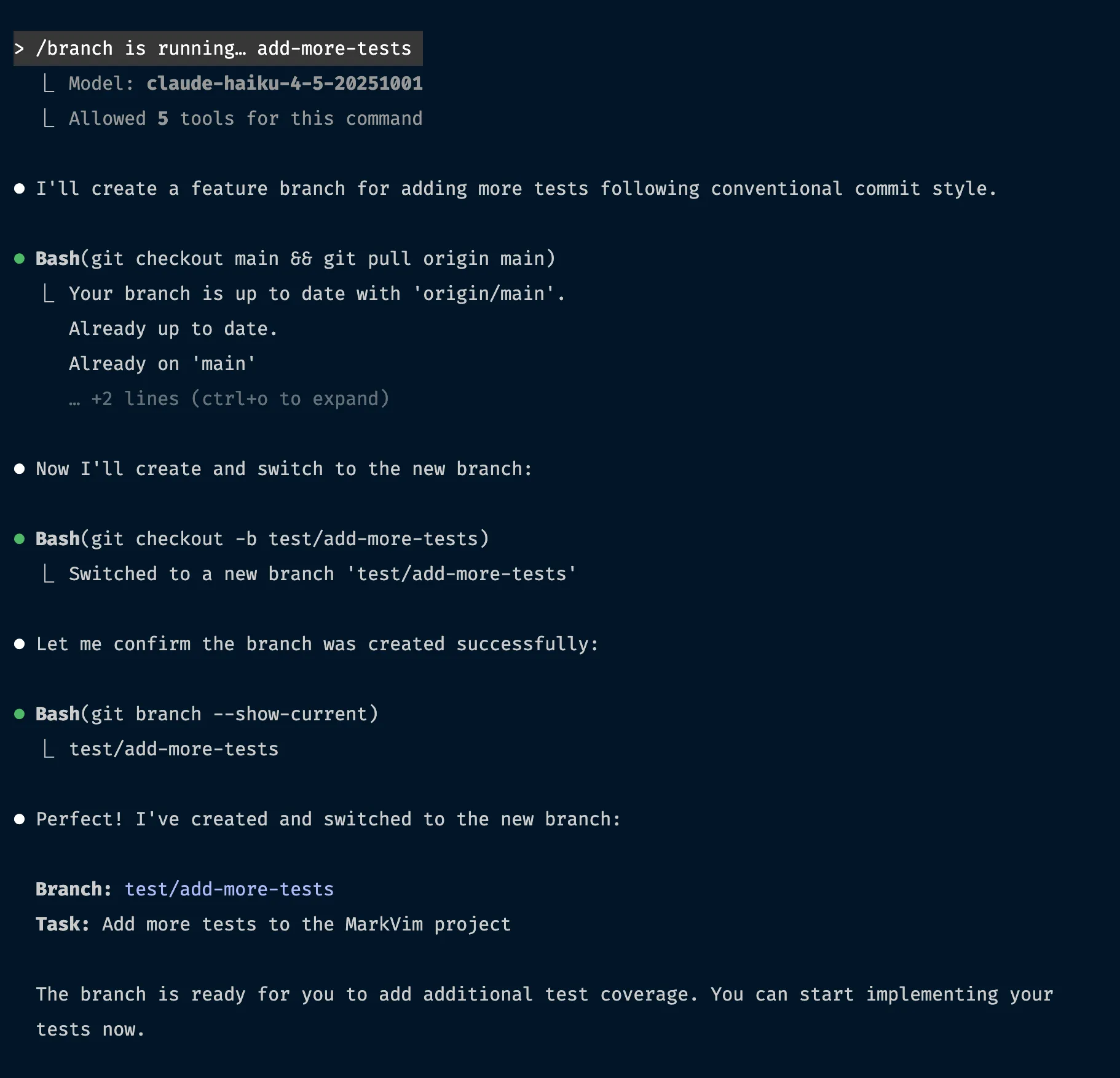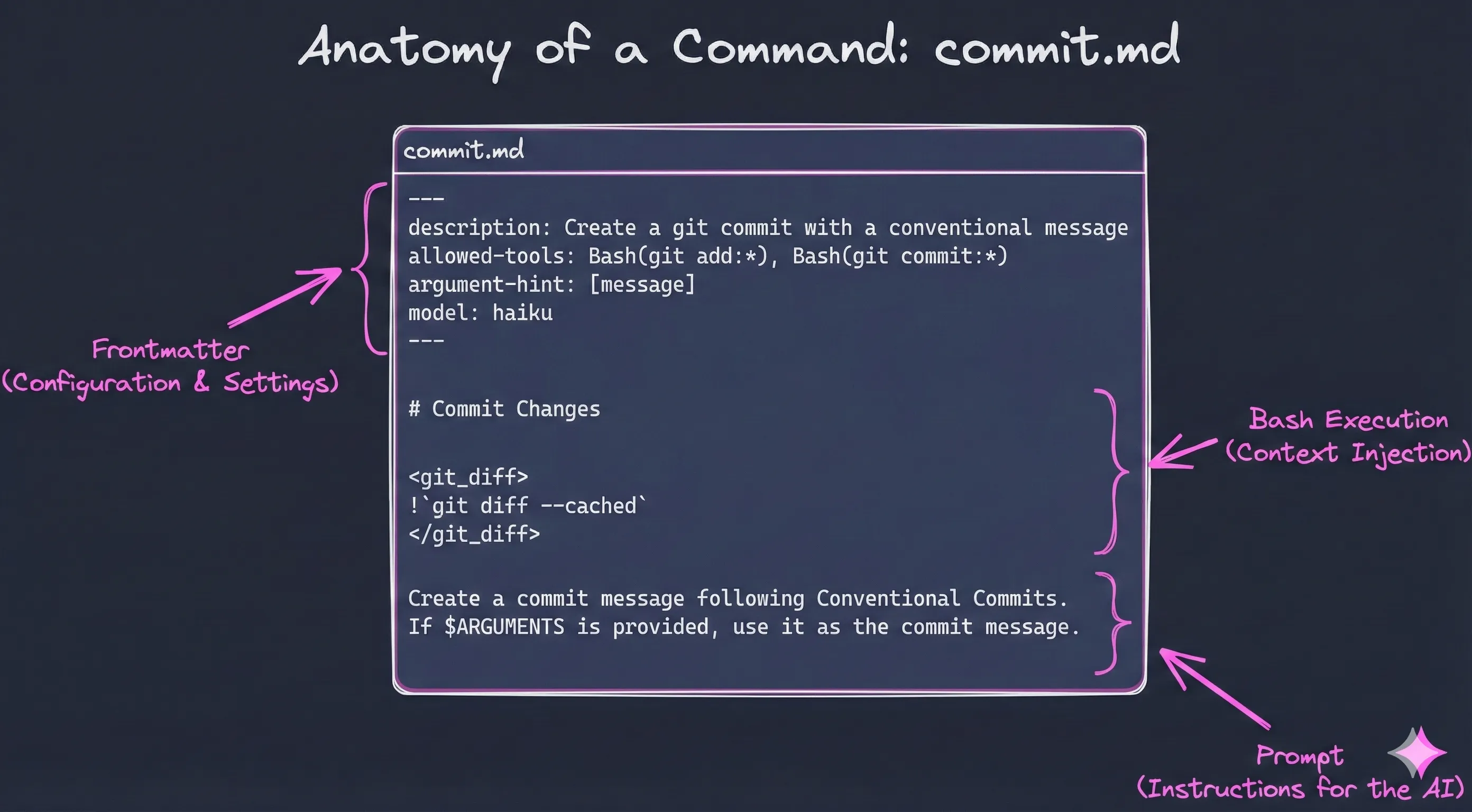I was wasting time. Every commit message, every branch name, every PR description. I typed the same things over and over.
Then I discovered Slash Commands in Claude Code. Now I type /commit and it writes the message for me. /branch "add dark mode" and it creates feat/add-dark-mode. /pr and it generates a full PR description from my commits.
This post shows you how to build the same workflow. I’ll cover how Slash Commands work, then we’ll build a complete system that automates your entire git lifecycle.

Prerequisites
You need Git and the GitHub CLI (gh). Install gh with brew install gh on macOS or check cli.github.com. Run gh auth login to authenticate.
Without gh, commands like /pr and /fix-pipeline will not work.
Two things you need to know
Before we build the workflow, you need to understand two features.
Bash command execution
Write !git status inside a command file. Claude runs the command first, captures the output, and injects it into the prompt. The AI sees the result before it starts thinking.
This is how /commit knows what you changed. It runs !git diff automatically. See the official documentation for more details.
Model selection
You don’t need a powerful model to fix a missing semicolon. Claude Code lets you pick the model in the frontmatter:
sonnet— for complex reasoning (default)haiku— fast and cheap
Add model: haiku and commands run almost instantly.
Command structure
Slash commands are Markdown files stored in .claude/commands/ (project-level) or ~/.claude/commands/ (personal). The filename becomes the command name: commit.md becomes /commit.
Here is a complete example:
---
description: Create a git commit with a conventional message
allowed-tools: Bash(git add:*), Bash(git commit:*)
argument-hint: [message]
model: haiku
---
# Commit Changes
<git_diff>
!`git diff --cached`
</git_diff>
Create a commit message following Conventional Commits.
If $ARGUMENTS is provided, use it as the commit message.
Frontmatter options
| Option | Purpose | Default |
|---|---|---|
description | Brief description shown in /help | First line of prompt |
allowed-tools | Tools the command can use | Inherits from conversation |
model | Model to use (sonnet, haiku, or full model ID) | Inherits from conversation |
argument-hint | Shows expected arguments in autocomplete | None |
Arguments
Use $ARGUMENTS to capture everything passed to the command:
Create a branch named: $ARGUMENTSFor multiple arguments, use positional parameters $1, $2, etc:
---
argument-hint: [pr-number] [priority]
---
Review PR #$1 with priority $2.File references
Include file contents with the @ prefix:
Review the implementation in @src/utils/helpers.jsThe workflow
I replaced my manual git rituals with custom commands. They live in .claude/commands/. Here is how I drive a feature from start to merge.
/branch — start a task
I type /branch "implement dark mode toggle" and Claude checks out main, pulls latest, and creates feat/dark-mode-toggle. No more thinking about naming conventions.
/lint — fix before commit
I type /lint. It runs the linter with auto-fix, and if errors remain, Claude fixes them. Uses Haiku for speed—runs in about 20 seconds.
/vitest — run unit tests
I type /vitest. It runs the test suite and fixes any failures. The prompt tells Claude to fix the code, not the test—implementation should match expected behavior.
/commit — save your work
I type /commit. Claude analyzes the diff, generates a Conventional Commit message, and commits. It looks at recent commits to match your project’s style.
/push — commit and push in one step
I type /push. It stages everything, generates a commit message, commits, and pushes. My most-used command—one word and the code is on GitHub.
/fix-pipeline — fix failing CI tests
I type /fix-pipeline. It fetches the failed logs via gh, analyzes the error, and fixes it. Uses Sonnet because debugging requires reasoning. The prompt includes guardrails—Claude must read the actual error before proposing fixes.
/pr — create a pull request
I type /pr. It analyzes all commits on the branch, generates a PR title and description, and opens it via gh pr create. Checks if a PR already exists first.
/review-coderabbit — address review comments
I type /review-coderabbit. It fetches CodeRabbit’s comments via GraphQL, verifies each suggestion against the codebase, implements valid fixes or pushes back with reasoning, and resolves every thread. AI reviewers aren’t always right—the prompt ensures Claude verifies before acting.
/merge-to-main — finish the task
I type /merge-to-main. It squash merges the PR, deletes the branch, and pulls main. Done.
Summary
By moving your process into .claude/commands/, you are building a system.
- Bash command execution injects real-time context
- Model selection balances speed vs reasoning
- The workflow automates branching, linting, committing, CI debugging, PRs, and merging
Define the process once. Claude executes it every time.
Want to extend Claude Code even further? Connect external tools via MCP (Model Context Protocol) What Is the Model Context Protocol (MCP)? How It Works Learn how MCP (Model Context Protocol) standardizes AI tool integration, enabling LLMs to interact with external services, databases, and APIs through a universal protocol similar to USB-C for AI applications. or package your commands into a shareable plugin Building My First Claude Code Plugin How I built a Claude Code plugin to generate skills, agents, commands, and more—and stopped copy-pasting boilerplate. .
I don’t think about naming conventions, commit messages, or PR descriptions anymore. The commands handle it.
Bonus: Shell aliases for even faster execution
You can skip the interactive prompt entirely with claude -p. Add aliases to your .zshrc or .bashrc:
alias clint="claude -p '/lint'"
alias cpush="claude -p '/push'"
alias ccommit="claude -p '/commit'"
alias cbranch="claude -p '/branch'"Now clint runs the lint command without opening the interactive session. The -p flag passes the prompt directly—Claude executes and exits. Two steps become one keystroke.